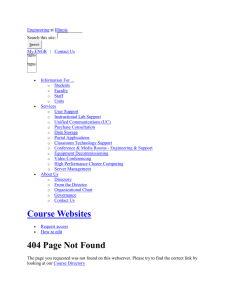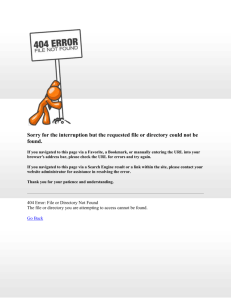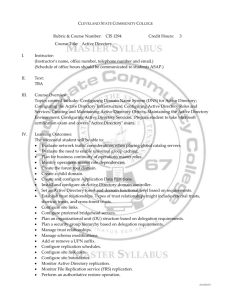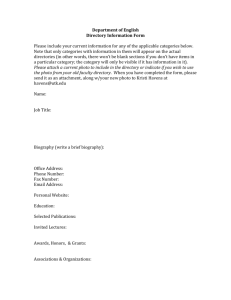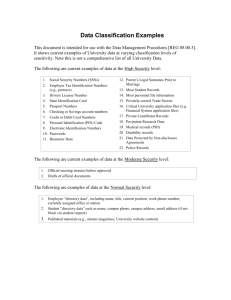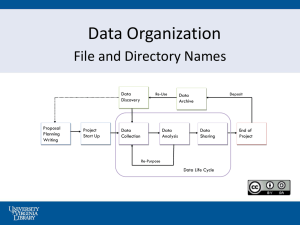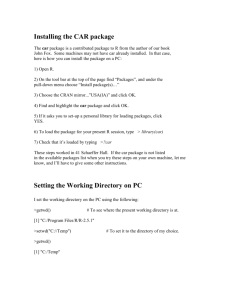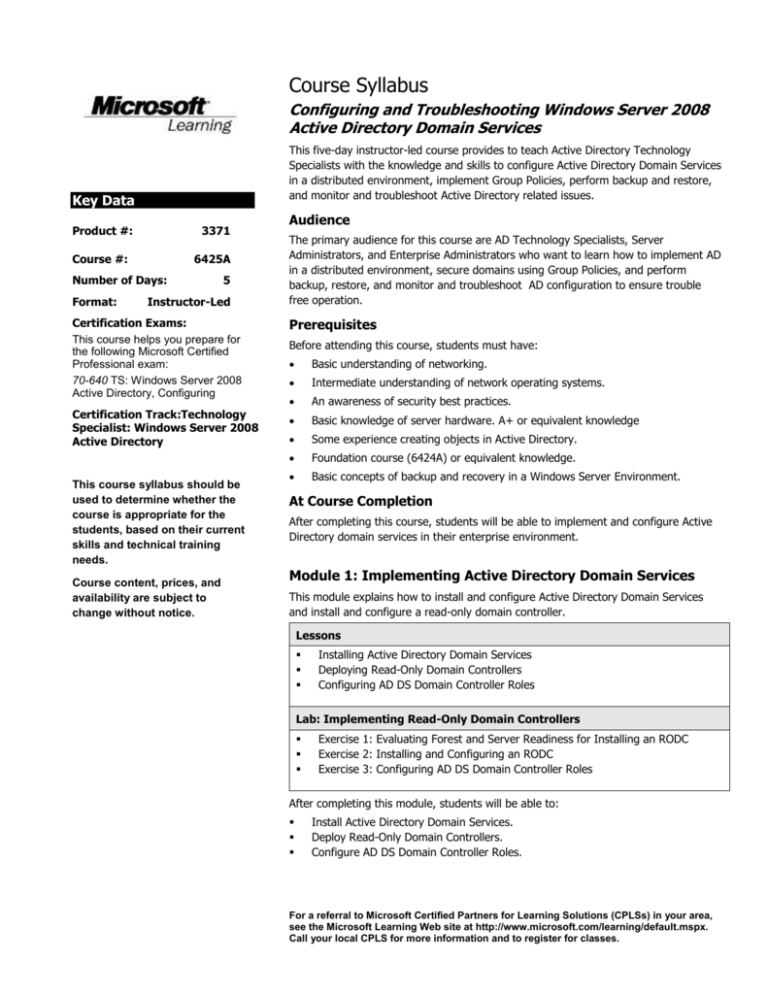
Course Syllabus
Configuring and Troubleshooting Windows Server 2008
Active Directory Domain Services
This five-day instructor-led course provides to teach Active Directory Technology
Specialists with the knowledge and skills to configure Active Directory Domain Services
in a distributed environment, implement Group Policies, perform backup and restore,
and monitor and troubleshoot Active Directory related issues.
Key Data
Product #:
3371
Course #:
6425A
Number of Days:
Format:
5
Instructor-Led
Certification Exams:
This course helps you prepare for
the following Microsoft Certified
Professional exam:
70-640 TS: Windows Server 2008
Active Directory, Configuring
Certification Track:Technology
Specialist: Windows Server 2008
Active Directory
This course syllabus should be
used to determine whether the
course is appropriate for the
students, based on their current
skills and technical training
needs.
Course content, prices, and
availability are subject to
change without notice.
Audience
The primary audience for this course are AD Technology Specialists, Server
Administrators, and Enterprise Administrators who want to learn how to implement AD
in a distributed environment, secure domains using Group Policies, and perform
backup, restore, and monitor and troubleshoot AD configuration to ensure trouble
free operation.
Prerequisites
Before attending this course, students must have:
Basic understanding of networking.
Intermediate understanding of network operating systems.
An awareness of security best practices.
Basic knowledge of server hardware. A+ or equivalent knowledge
Some experience creating objects in Active Directory.
Foundation course (6424A) or equivalent knowledge.
Basic concepts of backup and recovery in a Windows Server Environment.
At Course Completion
After completing this course, students will be able to implement and configure Active
Directory domain services in their enterprise environment.
Module 1: Implementing Active Directory Domain Services
This module explains how to install and configure Active Directory Domain Services
and install and configure a read-only domain controller.
Lessons
Installing Active Directory Domain Services
Deploying Read-Only Domain Controllers
Configuring AD DS Domain Controller Roles
Lab: Implementing Read-Only Domain Controllers
Exercise 1: Evaluating Forest and Server Readiness for Installing an RODC
Exercise 2: Installing and Configuring an RODC
Exercise 3: Configuring AD DS Domain Controller Roles
After completing this module, students will be able to:
Install Active Directory Domain Services.
Deploy Read-Only Domain Controllers.
Configure AD DS Domain Controller Roles.
For a referral to Microsoft Certified Partners for Learning Solutions (CPLSs) in your area,
see the Microsoft Learning Web site at http://www.microsoft.com/learning/default.mspx.
Call your local CPLS for more information and to register for classes.
Course Outline Configuring and Troubleshooting Windows Server 2008 Active
Directory Domain Services
Module 2: Configuring Domain Name Service for Active
Directory Domain Services
This module explains how to configure Domain Name Services (DNS) for Active
Directory Domain Services.
Lessons
Overview of Active Directory Domain Services and DNS Integration
Configuring Active Directory Integrated Zones
Configuring Read Only DNS Zones
Lab: Configuring AD DS and DNS Integration
Exercise 1: Configuring Active Directory Integrated Zones
Exercise 2: Configuring Read-Only DNS Zones
After completing this module, students will be able to:
Describe Active Directory Domain Services and DNS integration.
Configure Active Directory Integrated Zones.
Configure read only DNS zones.
Module 3: Configuring Active Directory Objects and Trusts
This module explains how to configure Active Directory Objects and Trusts.
Lessons
Configuring Active Directory Objects
Strategies for Using Groups
Automating AD DS Object Management
Delegating Administrative Access to AD DS Objects
Configuring AD DS Trusts
Lab A: Configuring Active Directory Objects
Exercise 1: Configuring AD DS Objects
Exercise 2: Implementing an AD DS Group Strategy
Exercise 3: Automating the Management of AD DS Objects
Lab B: Configuring Active Directory Objects and Trusts
Exercise 1: Delegating Control of AD DS Objects
Exercise 2: Configuring AD DS Trusts
After completing this module, students will be able to:
Configure Active Directory Objects.
Describe strategies for using groups.
Automate AD DS object management.
Delegate Administrative access to AD DS objects.
Configure AD DS trusts.
Module 4: Configuring Active Directory Sites and Replication
This module explains how to configure Active Directory sites and replication.
Course Outline Configuring and Troubleshooting Windows Server 2008 Active
Directory Domain Services
Lessons
Overview of AD DS Replication
Overview of AD DS Sites and Replication
Configuring and Monitoring AD DS Replication
Lab: Configuring Active Directory Sites and Replication
Exercise 1: Configuring AD DS Sites and Subnets
Exercise 2: Configuring AD DS Replication
Exercise 3: Monitoring AD DS Replication
After completing this module, students will be able to:
Describe AD DS replication.
Configure Active Directory Domain Services sites.
Configure and monitor AD DS replication.
Module 5: Creating and Configuring Group Policy
This module explains how to create and configure Group Policy.
Lessons
Overview of Group Policy
Configuring the Scope of Group Policy Objects
Evaluating the Application of Group Policy Objects
Managing Group Policy Objects
Delegating Administrative Control of Group Policy
Lab: Creating and Configuring GPOs
Exercise
Exercise
Exercise
Exercise
Exercise
1:
2:
3:
4:
5:
Creating Group Policy Objects
Managing the Scope of GPO Application
Verifying GPO Application
Managing GPOs
Delegating Administrative Control of GPOs
After completing this module, students will be able to:
Describe Group Policy.
Configure the scope of Group Policy objects.
Evaluate the application of Group Policy objects.
Manage Group Policy objects.
Delegate administrative control of Group Policies.
Module 6: Configuring User Environments Using Group Policy
This module explains how to configure user environments using Group Policy.
Lessons
Configuring Group Policy Settings
Configuring Scripts and Folder Redirection Using Group Policies
Configuring Administrative Templates
Group Policy Preferences
Deploying Software Using Group Policy
Lab Configuring User Environments Using Group Policies
Course Outline Configuring and Troubleshooting Windows Server 2008 Active
Directory Domain Services
Exercise
Exercise
Exercise
Exercise
1:
2:
3:
4:
Configuring Scripts and Folder Redirection
Configuring Administrative Templates
Configuring Preferences
Verifying GPO Application
After completing this module, students will be able to:
Configure Group Policy settings.
Configure scripts and folder redirection using Group Policy.
Configure administrative templates.
Describe Group Policy preferences.
Deploy software using Group Policy.
Module 7: Implementing Security Using Group Policy
This module explains how to implement security using Group Policy.
Lessons
Configuring Security Policies
Implementing Fine-Grained Password Policies
Restricting Group Membership and Access to Software
Managing Security Using Security Templates
Lab: Implementing Security Using Group Policies
Exercise
Exercise
Exercise
Exercise
Exercise
1:
2:
3:
4:
5:
Configuring Account and Security Policy Settings
Implementing Fine-Grained Password Policies
Configuring Restricted Groups and Software Restriction Policies
Configuring Security Templates
Verifying the Security Configuration
After completing this module, students will be able to:
Configure security settings.
Implement fine-grained password policies.
Restrict group membership and access to software.
Manage security using security templates.
Module 8: Implementing an Active Directory Domain Services
Monitoring Plan
This module explains how to implement Active Directory Domain Services monitoring
plan.
Lessons
Monitoring AD DS Using Event Viewer
Monitoring Active Directory Domain Servers Using Reliability and Performance
Monitor
Configuring AD DS Auditing
Lab: Monitoring Active Directory Domain Services
Exercise 1: Monitoring AD DS Using Event Viewer
Exercise 2: Monitoring AD DS Using Performance and Reliability Monitor
Exercise 3: Configuring AD DS Auditing
After completing this module, students will be able to:
Course Outline Configuring and Troubleshooting Windows Server 2008 Active
Directory Domain Services
Monitor Active Directory Domain Services using Event Viewer.
Monitor Active Directory Domain servers using reliability and performance
monitor.
Configure Active Directory Domain Services Auditing.
Module 9: Implementing an Active Directory Domain Services
Maintenance Plan
This module explains how to implement an Active Directory Domain Services
maintenance plan.
Lessons
Maintaining the AD DS Domain Controllers
Backing Up Active Directory Domain Services
Restoring Active Directory Domain Services
Lab: Implementing an Active Directory Domain Services Maintenance Plan
Exercise
Exercise
Exercise
Exercise
1:
2:
3:
4:
Maintaining AD DS Domain Controllers
Backing Up AD DS
Performing an Authoritative Restore of the AD DS Database
Restoring Data Using the AD DS Snapshot Viewer
After completing this module, students will be able to:
Maintain the AD DS Domain Controllers.
Back up the Active Directory Domain Services.
Restore the Active Directory Domain Services.
Module 10: Troubleshooting Active Directory, DNS, and
Replication Issues
This module explains how to troubleshoot Active Directory Domain Services, Domain
Name Service, and Active Directory replication.
Lessons
Troubleshooting Active Directory Domain Services
Troubleshooting DNS Integration with AD DS
Troubleshooting AD DS Replication
Lab: Troubleshooting Active Directory, DNS, and Replication Issues
Exercise 1: Troubleshooting Authentication and Authorization Errors
Exercise 2: Troubleshooting the Integration of DNS and AD DS
Exercise 3: Troubleshooting AD DS Replication
After completing this module, students will be able to:
Troubleshoot Active Directory Domain Services.
Troubleshoot DNS integration with AD DS.
Troubleshoot AD DS replication.
Module 11: Troubleshooting Group Policy Issues
This module explains how to troubleshoot the application of Group Policy objects.
Lessons
Course Outline Configuring and Troubleshooting Windows Server 2008 Active
Directory Domain Services
Introduction to Group Policy Troubleshooting
Troubleshooting Group Policy Application
Troubleshooting Group Policy Settings
Lab: Troubleshooting Group Policy Issues
Exercise
Exercise
Exercise
Exercise
1:
2:
3:
4:
Troubleshooting Group Policy Scripts
Troubleshooting GPO Lab11B
Troubleshooting GPO Lab11C
Troubleshooting GPO Lab11D
After completing this module, students will be able to:
Describe Group Policy troubleshooting.
Troubleshoot Group Policy application.
Troubleshoot Group Policy Settings.
Module 12: Implementing an Active Directory Domain
Services Infrastructure
This module explains how to implement an Active Directory Domain Services
Infrastructure.
Lessons
Overview of the AD DS Deployment
Planning a Group Policy Strategy
Lab A: Deploying Active Directory Domain Services
Exercise 1: Installing a Read-only Domain Controller (RODC) onto a Server Core,
and Creating a Branch Office Site
Exercise 2: Creating a Domain in a Separate Tree and Separate Site
Lab B: Configuring Forest Trust Relationships
Exercise: Upgrading the Fabrikam Domain, and Creating a Forest Trust with
Woodgrove Bank
Lab C: Planning a Group Policy Strategy
Exercise 1: Planning Group Policy
Exercise 2: Creating a Domain in a Separate Tree and Separate Site
Exercise 3: Implementing the Corporate Desktop Policy
After completing this module, students will be able to:
Implement an Active Directory Domain Services infrastructure.
© 2008 Microsoft Corporation. All rights reserved.
Some elements of this course syllabus are subject to change. This syllabus is for informational purposes
only. MICROSOFT MAKES NO WARRANTIES, EXPRESS OR IMPLIED, IN THIS SUMMARY.
Microsoft Active Directory Domain Services and Windows Server 2008 are either registered trademarks
or trademarks of Microsoft Corporation in the United States and/or other countries. Other product and
company names mentioned herein may be the trademarks of their respective owners.

